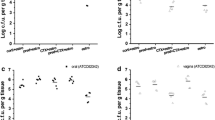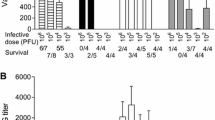Abstract
Vulvovaginal candidiasis (VVC) is regarded as an important public health issue, and several aspects of its pathogenesis are not yet sufficiently clear. Experimental in vivo models of vaginal infection with Candida albicans have been extremely useful in the identification of factors concerning hormonal influences on the infection, the virulence of the yeasts, the susceptibility, and the treatment of the infection. The development of easily manageable, reproducible, and economically viable animal models of VVC is highly important. We describe a simple experimental model of VVC in rats, using a pharmaceutical brand of estradiol hexa-hydrobenzoate for human treatment. All the steps of this model were standardized; and after the experiments, the rats were euthanized for further examination of their tissues by scanning and transmission electron microscopy. Standardized features included the use of non-ovariectomized rats, sterile distilled water as the hormone vehicle, estradiol hexa-hydrobenzoate administered at 0.20 mg/week/rat fractionated three times/week, and a yeast suspension of 5 × 108 yeasts/ml in a single vaginal administration 1 week after hormone induction. In this way, 100% of the rats were in pseudo-estrus and developed and maintained the infection until the third week of the experiment. Electron microscopy observation of the vagina of the rats confirmed the presence of both pseudo-estrus and vaginal infection. The standardized experimental model proved inexpensive, reproducible, and easily feasible for the induction of vaginal infection with C. albicans and may help to clarify important aspects of the pathogenesis and treatment of VVC.




Similar content being viewed by others
References
Sobel JD. Vulvovaginal candidosis. Lancet. 2007;369:1961–71.
Sobel JD. Candidal vulvovaginitis. Clin Obstet Gynecol. 1993;36:153–212.
Mardh PA, Rodrigues AG, Genc M, Nivikova N, Martinez-de-Oliveira J, Guaschino S. Facts and myths on recurrent vulvovaginal candidosis: a review on epidemiology, clinical manifestations, diagnosis, pathogenesis and therapy. Int J STD AIDS. 2002;13:522–39.
Souza PC, Storti-Filho A, Souza RJS, Damke E, Mello ICJ, Pereira MW, Svidizinski TIE, Lopes-Consolaro ME. Prevalence of Candida sp. in the cervical–vaginal cytology stained by Harris–Shorr. Arch Gynecol Obstet. 2009;279:625–9.
Patel DA, Gillespie B, Sobel JD, Leaman D, Nyirjesy P, Weitz MV, Foxman B. Risk factors for recurrent vulvovaginal candidiasis in women receiving maintenance antifungal therapy: results of a prospective cohort study. Am J Obstet Gynecol. 2004;190:644–53.
Corsello S, Spinillo A, Osnengo G, Penna C, Guaschino S, Beltrame A, Blasi N, Festa A. An epidemiological survey of vulvovaginal candidiasis in Italy. Eur J Obstet Gynecol Reprod Biol. 2003;110:66–72.
Sobel JD, Myers PG, Kayne D, Levison ME. Adherence of Candida albicans to human vaginal and buccal epithelial cells. J Infect Dis. 1981;143:76–82.
Irie MMT, Consolaro MEL, Guedes TA, Donatti L, Patussi EV, Svidzinski TIE. A simplified technique for evaluating the adherence of yeasts to human vaginal epithelial cells. J Clin Lab Anal. 2006;20:195–203.
Alvares CA, Svidzinski TIE, Consolaro MEL. Vulvovaginal candidíasis: susceptibility factors of the host and virulence of the yeasts. J Bras Patol Med Lab. 2007;43:319–27.
Kalo-Klein A, Witkin SS. Candida albicans: cellular immune system interactions during different stages of the menstrual cycle. Am J Obstet Gynecol. 1989;161:1132–6.
Sobel JD. Pathogenesis and epidemiology of vulvovaginal candidiasis. Ann N Y Acad Sci. 1988;544:547–57.
Kaushic C, Zhou F, Murdin AD, Wira CR. Effects of estradiol and progesterone on susceptibility and early immune responses to Chlamydia trachomatis infection in the female reproductive tract. Infect Immun. 2000;68:4207–16.
Cruz FCM, Soares-Júnior JM, Mosquette R, Simões MJ. Aspectos morfológicos da junção escamo-colunar de ratas em estro permanente e tratadas com associação de estrogênio e glicocorticóide. Rev Bras Ginecol Obstet. 2004;26:597–602.
Mandl AM, Zuckerman S. Numbers of normal and atretic oocytes in unilaterally spayed rats. J Endocrinol. 1951;7:112–9.
Sobel JD, Muller G, McCormick JF. Experimental chronic vulvovaginal candidiasis. Sabour. 1985;23:199–206.
Fidel PL Jr, Lynch ME, Sobel JD. Candida-specific cell-mediated immunity is demonstrable in mice with experimental vaginal candidiasis. Infect Immun. 1993;61:1990–5.
Clemons KV, Spearow JL, Parmar R, Espiritu M, Stevens DA. Genetic susceptibility of mice to Candida albicans vaginitis correlates with host estrogen sensitivity. Infect Immun. 2004;72:4878–80.
Fidel PL Jr, Cutright J, Steele C. Effects of reproductive hormones on experimental vaginal candidiasis. Infect Immun. 2000;68:651–7.
National Committee for Clinical Laboratory Standards (NCCLS). Reference TEMhod. Wayne: NCCLS; 1998.
Kurtzman CP, Fell JW. The yeast. A taxonomic study. Amsterdam: Elsevier; 1998.
Sugita T, Kurosaka S, Yajite M, Sato H, Nishikawa A. Extracellular proteinase and phospholipase activity of three genotypic strains of a human pathogenic yeast, Candida albicans. Microbiol Immunol. 2002;46:881–3.
De Bernardis F, Lucciarini R, Boccanera M, Amantini C, Arancia S, Morrone S, Mosca M, Cassone A, Santoni G. Phenotypic and functional characterization of vaginal dendritic cells in a rats model of Candida albicans vaginitis. Infect Immun. 2006;74:4282–94.
Wozniak KL, Wormley FL Jr, Fidel PL Jr. Candida-specific antibodies during experimental vaginal candidiasis in mice. Infect Immun. 2002;70:5790–9.
Yener T, Tunc AT, Aslan H, Aytan H, Caliskan AC. Determination of oestrous cycle of the rats by direct examination: how reliable? Anat Histol Embryol. 2007;36:75–7.
Author information
Authors and Affiliations
Corresponding author
Rights and permissions
About this article
Cite this article
Carrara, M.A., Donatti, L., Damke, E. et al. A New Model of Vaginal Infection by Candida albicans in Rats. Mycopathologia 170, 331–338 (2010). https://doi.org/10.1007/s11046-010-9326-1
Received:
Accepted:
Published:
Issue Date:
DOI: https://doi.org/10.1007/s11046-010-9326-1




